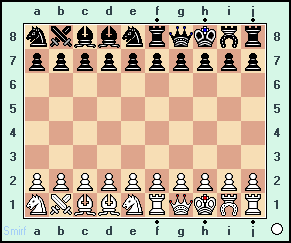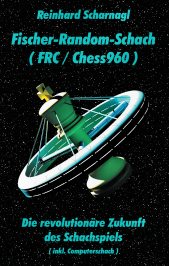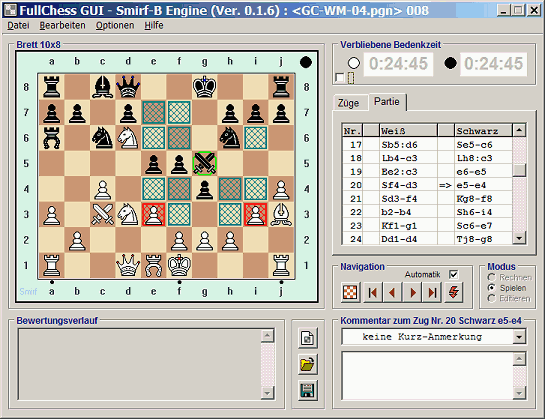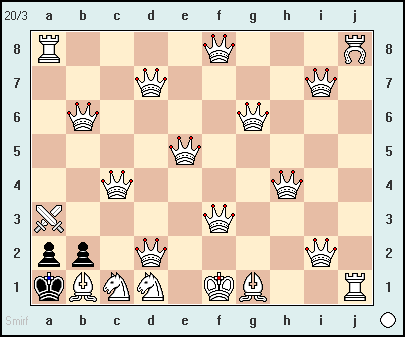Capablanca Random Chess

Introduction

This game was voted the winner of the Chess Variant Pages 10th aniversary design contest, submitted by the late Reinhard Scharnagl. It was created to extend the concepts of Fischer Random Chess to Capablanca's Chess. Specifically, it had the following goals:
- creating an interesting drosophila for chess programmers
- using Capablanca's 10x8 Chess board geometry
- using Capablanca's piece set (incl. archbishop and chancellor)
- applying rules aligned to Fischer Random Chess
- avoid violating any patents
Setup
At the start of the game, a randomized setup is selected with the following restrictions:
- The Bishops must be on different colored squares.
- The King must be placed between the Rooks to allow castling.
- All Pawns must be protected.
This Interactive Diagram will randomize the position when you click Restart after first clicking Play It! While it should abide by the first two restrictions, it may not abide by the third. In that case, click Restart again until the position is legal.
Rules
The rules to CRC are as follows:
a) creating a starting position (one of 48.000):
- the bishops have to be placed upon different colored squares; same rule applies to the implicite bishop pieces: queen and archbishop (aligned to FRC)
- the king always has to be placed somewhere between the rooks to enable castlings (aligned to FRC)
- use only such positions without unprotected pawns (Chess)
- select queen or the archbishop to be placed first (2x)
- place the selected 1st piece upon a bright square (5x)
- place the selected 2nd piece upon a dark square (5x)
- one bishop has to be placed upon a bright square (4x)
- one bishop has to be placed upon a dark square (4x)
- one chancellor has to be placed upon a free square (6x)
- one knight has to be placed upon a free square (5x)
- one knight has to be placed upon a free square (4x)/2
- set the king upon the center of three free squares left
- set the rooks upon the both last free squares left
- this establishes White's first row, the Black side has to be built up symmetrically to this
- place ten pawns similar to traditional chess in a row
- skip spositions that have unprotected pawns or violate any patent.
- thus there exists a fixed correlation number to position
c) nature of (asymmetric Fischer-) castlings:
- castlings are (like in traditional chess) only valid if neither the affected king or rook has been moved, or there would be a need to jump over any third piece, or the king would be in chess somewhere from his starting position to his target field (both included). Therefore all squares between king and its target square (included) have to be free from third pieces, same applies to the way the rook has to go to its target square.
- the alpha-castling (O-O-O, White's left side): like in FRC the king will be placed two rows distant from the border (here c-file) and the rook at the next inner neighboured square.
- the omega-castling (O-O, White's right side): like in FRC the king will be placed one row distant from the border (here i-file) and the rook at the next inner neighboured square.
- move the king outside of the board
- move the rook to its end position (if need be)
- move the king to his end position
- the extended X-FEN could be used as a base
- 'a'/'A' are used to identify archbishops
- 'c'/'C' are used to identify chancellors
- '9' is used to mark nine empty squares
- "10" is used to encode ten empty squares
- if a castling enabled rook is not the most outer one at that side, the letter of his file has to be placed immediately following his castling marker symbol, where 'q'/'Q' are used for the alpha-, 'k'/'K' for omega-side.
g) comments and examples:
- this variant has been mentioned first in my book "Fischer-
Random-Schach (FRC / Chess960)", Page 83, June 2004,
Books on Demand GmbH, Norderstedt, ISBN 3-8334-1322-0

- there is a shrinked beta chess engine with GUI "Smirf",
which is able to play Chess, Chess960 and CRC, see at:
http://www.chessbox.de/beta.html

- there also is a suggestion of mine to rename the two
additional piece types, giving them better matching
names, trying to associate their nature:
a) (B+N) = A Archangel, symbolized by swords, reminding on an archangel defending the paradise

b) (R+N) = C Centaur, symbolized by a combination of a tower upon a horseshoe (horse nature below),

- for proposed symbols of the two additional pieces types and their estimated values see at: http://www.chessbox.de/Compu/schachveri1_e.html

Reinhard Scharnagl.
Webpage created: February 24, 2005.
Webpage updated: October 6, 2018 by Greg Strong.
Written by Reinhard Scharnagl.